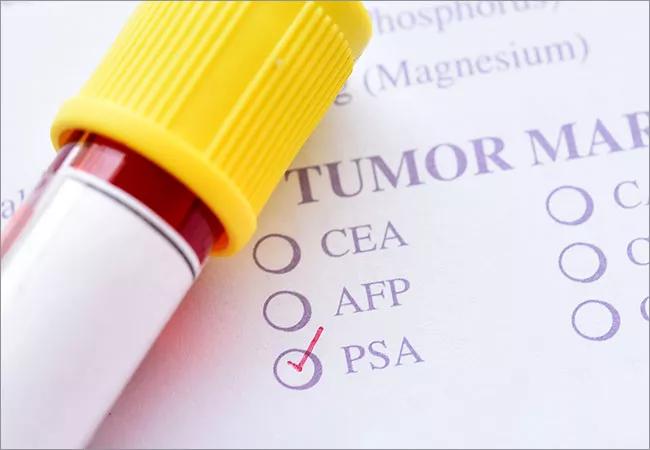Relapse more likely with faster PSA doubling time

The integration of prostate-specific antigen (PSA) kinetics into a nomogram widely used to predict outcomes of salvage therapy offers physicians and patients a more nuanced, longer-term look at prostate cancer-specific outcomes.
Advertisement
Cleveland Clinic is a non-profit academic medical center. Advertising on our site helps support our mission. We do not endorse non-Cleveland Clinic products or services. Policy
In 2007, a multi-institutional cohort led by Cleveland Clinic’s Glickman Urological and Kidney Institute developed a nomogram to predict prostate cancer-specific and all-cause mortality at six years after salvage radiotherapy (SRT).
Almost a decade later, a study led by Cleveland Clinic Cancer Center radiation oncologist Rahul D. Tendulkar, MD, updated the nomogram with evidence that early initiation of SRT following radical prostatectomy (RP) reduced biochemical failure (BF) and distant metastases (DM).
The researchers’ most recent update to the nomogram was presented at the 2019 annual meeting of the American Society for Radiation Oncology (ASTRO).
“One critique of our previous update was the lack of PSA kinetics among the predictive factors,” says Shauna Campbell, DO, chief resident, radiation oncology, Cleveland Clinic. “This version of the nomogram adds initial postoperative PSA level and PSA doubling time [PSADT] to the picture.”
Early versions of the nomogram included patients from 10 consortium institutions, in many of whom researchers could not accurately estimate PSADT. For this study, the team narrowed the data to 1,005 patients from five institutions with available PSA kinetic data, and were able to calculate PSADT from 662 of them. Study subjects had node-negative prostate cancer with median pre-SRT PSA levels of 0.4 ng/mL, with a median follow up of five years.
The team performed multivariable analyses (MVA) by Cox proportional hazards regression to pinpoint risk factors for DM and BF (defined as post-SRT PSA > 0.2 ng/mL). Most subjects had a Gleason score (GS) of 7 (n = 632, 63%), with 20% having GS 6 (n = 197) and 9% each with GS 8 (n = 86) and GS 9-10 (n = 90). Fifty-four percent of subjects had extraprostatic extension (EPE), and 19% had seminal vesicle invasion (SVI). Margins were positive in 59%. Thirteen percent received concurrent androgen deprivation therapy (ADT), 46% were treated to ≥ 66 Gy and 20% received pelvic RT.
Advertisement
MVA showed that pre-SRT PSA and PSADT were significantly associated with BF, along with GS, surgical margins, use of ADT, RT dose ≥ 66 Gy, pelvic nodal RT and SVI.
PSADT and pre-SRT PSA were also significantly associated with DM, in addition to GS, surgical margins, SVI and pelvic nodal RT. Specifically, PSADT of less than 6 months was significantly associated with increased DM (hazard ratio [HR] 2.6, P = 0.015) and BF (HR 1.5, P = 0.018). “We did not find a significant association in the PSADT 6- to 12-month group,” notes Dr. Campbell. “The faster a patient’s PSA doubling time, the more likely they are to experience recurrence after SRT.”
The team also noted a significant association between an initial postoperative PSA of ≥ 0.5 ng/mL and risk of BF, when compared with a postoperative PSA of < 0.2 ng/mL (HR 1.4, P = 0.046).
“Our results confirm our previous finding that early SRT at lower pre-SRT levels improves rates of recurrence,” says Dr. Campbell. “Incorporating PSA kinetics allows us a more precise look at potential outcomes.”
Patients with prostate cancer are a heterogenous group, making mortality and outcomes prediction complex for physicians to calculate and share.
“Our nomogram update adds an important tool in the physician-patient discussion, because it takes 12 individual characteristics into consideration, so it’s quite personalized,” says Dr. Campbell. “Patients with this disease are very interested in long-term outcome estimates, and we want to offer them the best answers possible with this 10- and 15-year prediction.”
Advertisement
A preview of the nomogram was presented at ASTRO, and the team is developing an online calculator built from the nomogram that will be available to providers and patients within the next year.
Advertisement
Advertisement

Obstructing key protein allows for increased treatment uptake for taxane chemotherapy

Oral medication reduces epistaxis and improves quality of life for patients with rare vascular disorder

Findings could help with management of a common, dose-limiting side effect

Enfortumab vedotin plus pembrolizumab benefited patients, regardless of biomarker expression

Treatment involved checkpoint inhibitor, surgery and intravesical therapy

Researchers Assess Real-Life Experiences of Patients Treated Outside of Clinical Trials

Multi-specialty coordination essential for improving quality of life